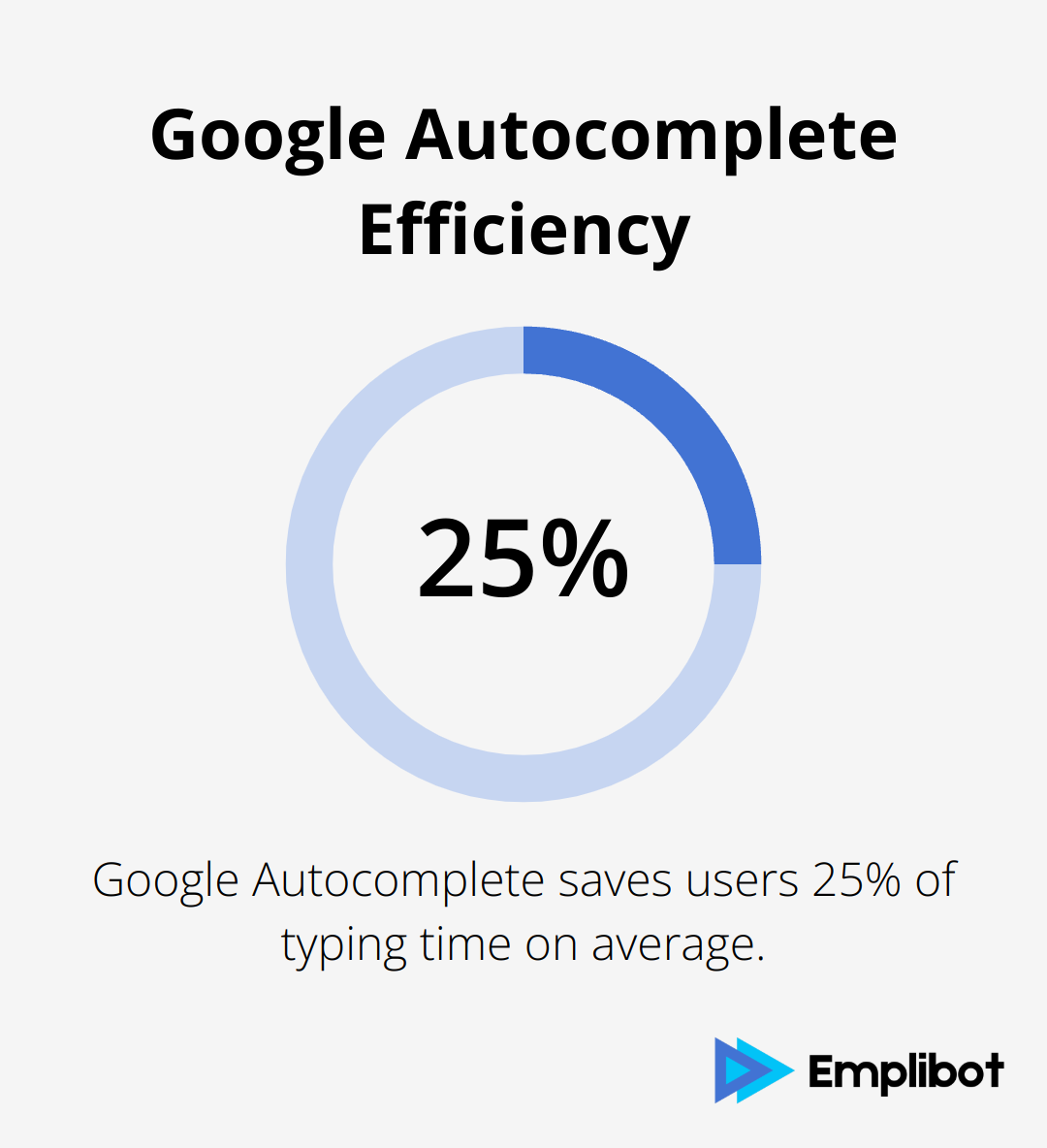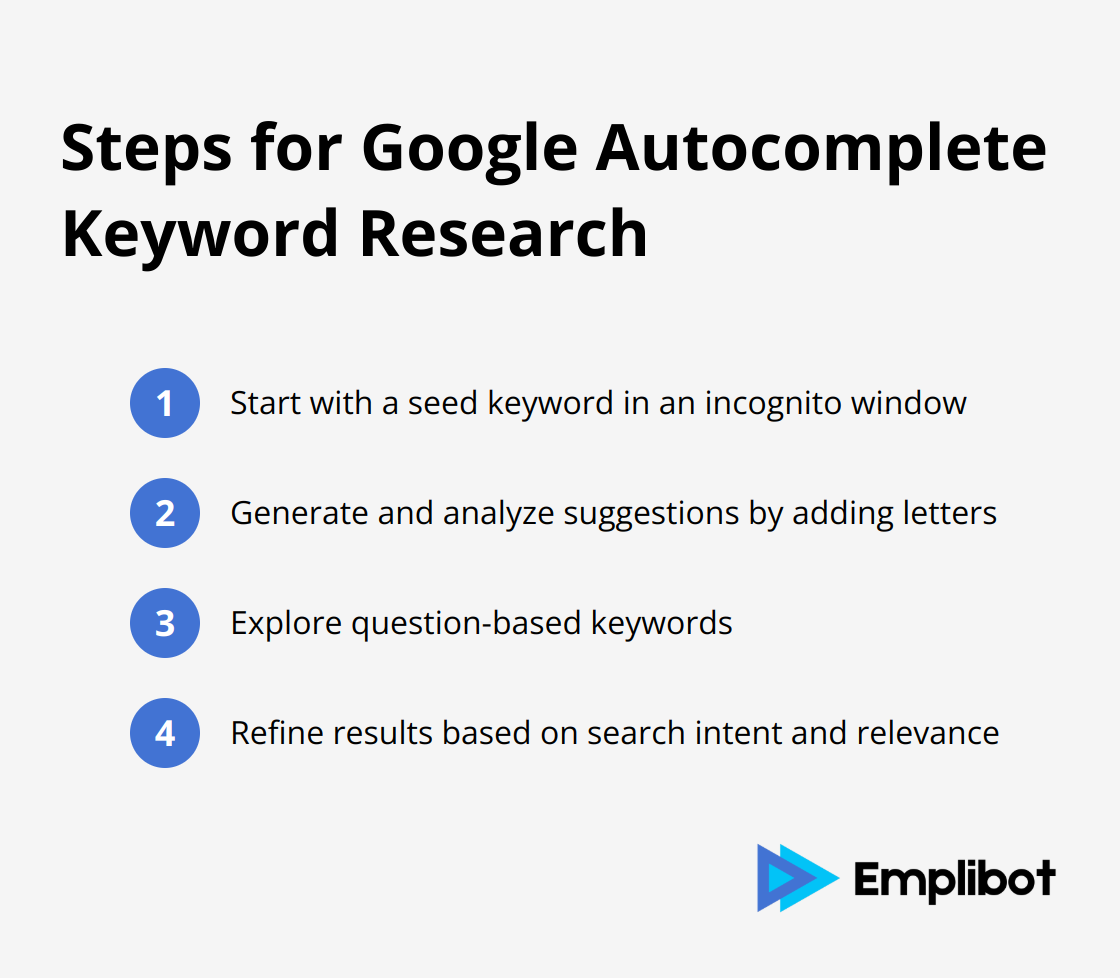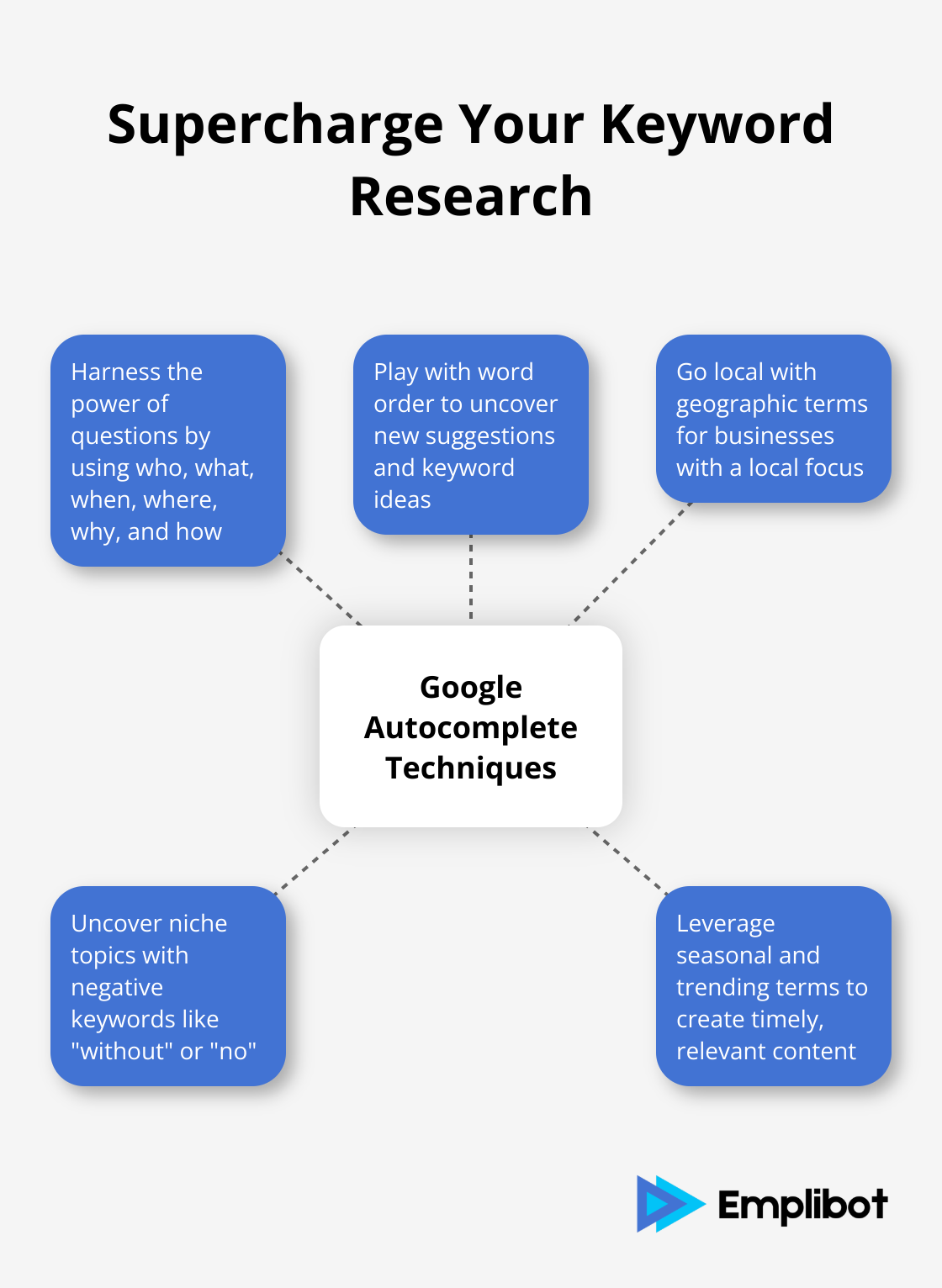At Emplibot, we’re always looking for ways to help content creators work smarter, not harder. That’s why we’re excited to share a powerful, yet often overlooked tool for keyword research: Google Autocomplete.
This free feature can uncover a treasure trove of keyword ideas, helping you identify low-competition topics that your audience is actively searching for. In this guide, we’ll show you how to harness Google Autocomplete for keyword research and boost your content strategy.
Contents
ToggleWhat Is Google Autocomplete?
A Powerful Keyword Research Tool
Google Autocomplete is a feature that predicts and suggests search queries as you type. This tool uses real searches performed by users worldwide, making it a valuable resource for content creators and marketers. It’s not just a time-saver for searchers; it’s a goldmine for keyword research.
The Inner Workings of Google Autocomplete
Google’s algorithm analyzes billions of searches to generate these predictions. It considers factors like search popularity, your location, and sometimes your search history. For instance, if you’re in New York and start typing “best pizza,” you might see suggestions like “best pizza in Brooklyn” or “best pizza Manhattan.”
Real User Data: The Secret Sauce
The value of Google Autocomplete lies in its foundation of actual user behavior. These aren’t random suggestions; they’re insights into what people actively search for. Google reports that Autocomplete saves users about 25% of typing time on average. For marketers, this translates to a direct line into the minds of their target audience.

Unearthing Long-Tail Keywords
One of the biggest advantages of using Google Autocomplete for keyword research is its ability to reveal long-tail keywords. These longer, more specific phrases often have lower search volume but higher conversion potential. Instead of just “running shoes,” you might discover “best running shoes for flat feet” or “lightweight running shoes for marathons.”
Targeting these specific, low-competition keywords can drive targeted traffic and boost conversions. It’s not about getting the most traffic; it’s about getting the right traffic.
Google Autocomplete provides the raw material, but it’s up to you to analyze these suggestions, understand the search intent behind them, and create content that meets those needs. In the next section, we’ll explore the practical steps to use this tool effectively for your keyword research.
It’s worth noting that Google isn’t the only platform with an autocomplete feature. Other popular search engines and platforms, like YouTube, also offer similar functionality, which can be equally valuable for keyword research in their respective domains.
How to Use Google Autocomplete for Keyword Research
Google Autocomplete is a powerful tool for keyword research. This method is straightforward and doesn’t require any special tools or software. Let’s explore the process.

Start with a Seed Keyword
Open Google in an incognito or private browsing window. This prevents your search history from influencing the results. Type in a broad keyword related to your topic. For example, if you’re in the fitness industry, you might start with “workout.”
Generate and Analyze Suggestions
As you type, Google will suggest popular searches. These suggestions are valuable for keyword research. They show you what people actually search for.
After typing your seed keyword, add a space and then a letter of the alphabet. Google will now show suggestions starting with that letter. For instance, “workout a” might suggest “workout apps” or “workout at home.”
Go through the alphabet, and note down relevant suggestions. Pay special attention to long-tail keywords – these often have less competition and more specific intent.
Explore Question-Based Keywords
People often use Google to ask questions. Capitalize on this by adding question words to your seed keyword. Try “how workout,” “why workout,” “when workout,” and so on. These can reveal valuable content ideas and potential article titles.
Refine Your Results
As you collect keywords, think about search intent and relevance to your business. A fitness blog might find “workout plan for beginners” more valuable than “workout clothes” (unless you’re selling fitness apparel).
Also, consider the competition. While “best workout routine” might be popular, it’s likely highly competitive. Look for more specific, niche keywords that you can realistically rank for.
This process takes time, but it’s worth the effort. You’re getting insights directly from what Google users search for, which is invaluable for your content strategy.
The consistent use of this method will help you build a robust list of keywords that can fuel your content calendar for months. And the best part? It’s completely free.
Now that you understand how to use Google Autocomplete for keyword research, let’s move on to some tips that will help you maximize your results.
Supercharge Your Keyword Research
Harness the Power of Questions
People often turn to Google with questions. Use question words like who, what, when, where, why, and how before your seed keyword. For instance, if your seed keyword is “digital marketing,” try “how digital marketing,” “why digital marketing,” or “when digital marketing.” This approach reveals valuable long-tail keywords and content ideas that directly address user queries.
Play with Word Order
Don’t limit yourself to a single keyword arrangement. Experiment with different word orders to uncover new suggestions. For example, “marketing digital” might yield different results than “digital marketing.” This simple switch exposes you to a whole new set of keyword ideas you might have otherwise missed.

Go Local with Geographic Terms
If you target a specific location, incorporate geographic terms into your searches. This strategy proves particularly useful for businesses with a local focus. Try to combine your seed keyword with city names, neighborhoods, or even landmarks (e.g., “coffee shops in Central Park” or “best pizza Lower East Side”). This helps you tap into local search intent.
Uncover Niche Topics with Negative Keywords
Here’s a clever trick: use negative keywords to drill down into niche topics. Start with your seed keyword, then add “without” or “no” followed by a common element in your industry. For example, if you’re in the fitness industry, try “workout without equipment” or “diet no carbs.” This technique helps you discover underserved niches or unique angles for your content.
Leverage Seasonal and Trending Terms
Timing matters in content marketing. Use Google Autocomplete to identify seasonal trends or current hot topics in your industry. Try to add terms like “2025,” “trends,” or “future” to your seed keywords. This helps you create timely, relevant content that captures current user interest.
These techniques will help you extract more value from Google Autocomplete and build a richer, more diverse keyword list. The goal isn’t just to find keywords; it’s to uncover the specific phrases and topics your audience actively searches for. This targeted approach will help you create content that truly resonates with your readers and improves your search engine visibility.
Final Thoughts
Google Autocomplete for keyword research offers a powerful, free method to uncover valuable insights into user searches. This approach reveals long-tail keywords, niche topics, and question-based queries that can fuel your content strategy. Patience and creativity are essential when using this technique to build a comprehensive list of potential topics.
Manual keyword research with Google Autocomplete is effective but can take time. Emplibot provides an automated solution for ai keyword research to streamline content marketing efforts. Our tool handles keyword research, content creation, and SEO optimization to help increase your traffic, leads, and sales.
The combination of Google Autocomplete insights and AI-driven content creation allows you to develop a robust, data-driven content strategy. This approach (whether manual or automated) helps you create valuable content that meets your audience’s needs and grows your business.

![Google Autocomplete for Keyword Research [Guide]](https://wp.emplibot.com/wp-content/uploads/emplibot/google-autocomplete-for-keyword-research-1753600089-768x456.jpeg)
![AI Marketing: Lead Generation [Guide]](https://wp.emplibot.com/wp-content/uploads/emplibot/ai-marketing-lead-generation-1753859292-768x456.jpeg)
![AI Marketing: Predictive Lead Scoring [Guide]](https://wp.emplibot.com/wp-content/uploads/emplibot/predictive-lead-scoring-1753772819-768x456.jpeg)






